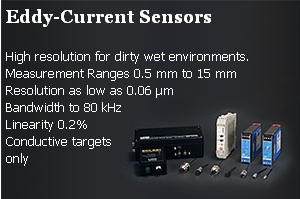|


LION涡流传感器.
Lion Precision Eddy-Current Sensors Overview This single page will give you an overview of eddy-current sensor operation, application, theory, and resources. Links to more detailed information are also provided. 2010 Survey Response “I tested your Eddy Current sensors against 3 other brands for thermal stability & you were best by far. Service and support have always been great. Lion Precision is always very flexible and willing to meet our needs as they change.” Or you can go directly to one of these pages: Eddy-Current Sensor Product Selector Eddy-Current Literature/Manual Downloads Comparison of Eddy-Current and Capacitive Sensors Eddy-Current sensors are noncontact devices capable of high-resolution measurement of the position and/or change of position of any conductive target. Eddy-Current sensors are also called inductive sensors, but generally "eddy current" refers to precision displacement instruments (or nondestructive testing probes) and "inductive" refers to inexpensive proximity switches. High resolution and tolerance of dirty environments make eddy-current sensors indispensable in today's modern industrial operations. Below you will find: Basic Theory, High-Performance Eddy-Current Sensors, Eddy-Current Sensor Advantages, Applications, and Products Overview. Basic Theory Eddy-Current sensors operate with magnetic fields. The driver creates an alternating current in the sensing coil in the end of the probe. This creates an alternating magnetic field with induces small currents in the target material; these currents are called eddy currents. The eddy currents create an opposing magnetic field which resists the field being generated by the probe coil. The interaction of the magnetic fields is dependent on the distance between the probe and the target. As the distance changes, the electronics sense the change in the field interaction and produce a voltage output which is proportional to the change in distance between the probe and target. High-Performance Sensors High performance eddy-current sensors It is important to distinguish between "high-performance" eddy-current sensors and inexpensive inductive sensors. Simple inductive sensors, such as those used in inexpensive proximity switches, are very basic devices. Proximity type sensors are tremendously useful in automation applications and many commercially available models are well made, but they are not suited to precision metrology applications. In contrast, eddy-current sensors for use in precision displacement measurement and metrology applications use complex electronic designs to execute complex mathematical algorithms. Unlike inexpensive sensors, these high-performance sensors have outputs which are very linear, stable with temperature, and able to resolve incredibly small changes in target position resulting in high resolution measurements. Eddy-Current Sensor Advantages Compared to other noncontact sensing technologies such as optical, laser, and capacitive, high-performance eddy-current sensors have some distinct advantages. Tolerance of dirty environments Not sensitive to material in the gap between the probe and target Less expensive and much smaller than laser interferometers Less expensive than capacitive sensors Eddy-Current sensors are not a good choice in these conditions: Extremely high resolution (capacitive sensors are ideal) Large gap between sensor and target is required (optical and laser are better) Visit the Eddy-Current vs. Capacitive Sensors page for a more detailed comparison between these two technologies. Applications Eddy-Current sensors are useful in any application requiring the measurement or monitoring of the position of a conductive target, especially in a dirty environment. Position Measurement/Sensing Eddy-Current sensors are basically position measuring devices. Their outputs always indicate the size of the gap between the sensor's probe and the target. When the probe is stationary, any changes in the output are directly interpreted as changes in position of the target. This is useful in: Automation requiring precise location Machine tool monitoring Final assembly of precision equipment such as disk drives Precision stage positioning Dynamic Motion Measuring the dynamics of a continuously moving target, such as a vibrating element, requires some form of noncontact measurement. Eddy-Current sensors are useful whether the environment is clean or dirty and the motions are relatively small. Lion Precision eddy-current sensors also have high frequency response (up to 80kHz) to accommodate high-speed motion. Drive shaft monitoring Vibration measurements Eddy-Current Sensor Products Overview High-performance eddy-current sensors consist of an electronics module and probe which is connected to the module by a cable. These systems are available in different configurations and price points. The ECL202 Eddy-Current Sensor is our best eddy-current product. Digital technology brings the highest linearity, resolution, and temperature stability. A setpoint switched output allows you to monitor a process and trigger an action when needed. The offset and and setpoint threshold are set with pushbutton controls. The module can be operated with other ECL202 modules and has the option of a rear connector DIN rail bus for multiple modules. The ECL101 is based on analog circuitry and features good performance in both linearity and resolution. The ECL101 can achieve bandwidths as high as 80kHz,making it an excellent choice for high-frequency applications. It includes a screw-adjust offset and voltage and current outputs. The ECA100 is a lower cost eddy-current sensor. The output is nonlinear, but the sensor includes a setpoint switch which can monitor a process and call for action when the process reaches a critical point. It has screw-adjust offset and gain controls so you can optimize this sensor in your application for the best possible performance at a lower cost. The ECD140 is a digital, high-performance sensor module for National Instrument's CompactRIO and LabVIEW systems. The module plugs into existing CompactRIO systems for simplified addition of displacement sensing to existing control systems. The ECD140 is based on the same design as the ECL202 and has similar performance. The ECA110 is an OEM version of ECA100 for embedded systems. Each PCB is custom designed with your components for your calibrations and requires minimum quantity orders. There are no user adjustments or indicators making it perfect for embedded systems where the sensor is out and sight. For more detail on eddy-current sensor products, visit the Eddy-Current Sensor Products page.
|